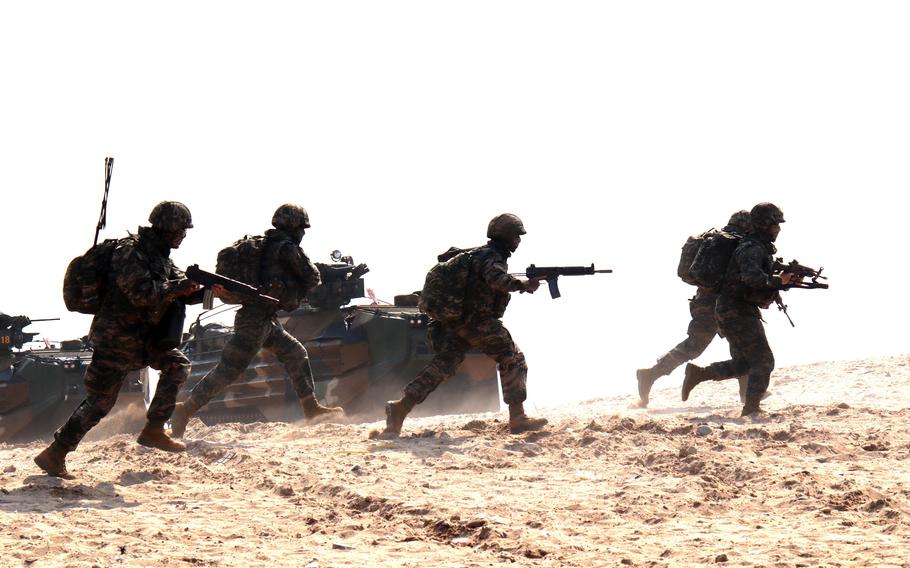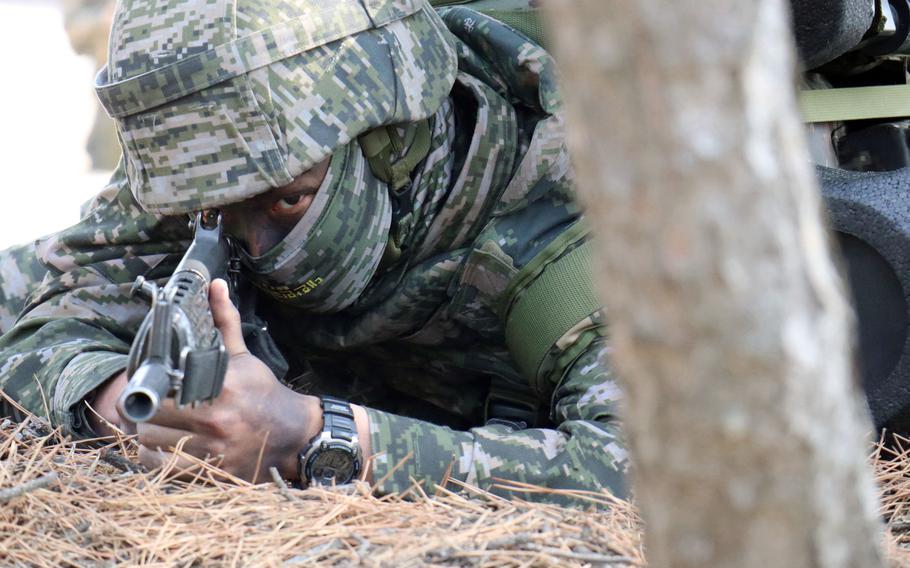
South Korean marines run toward cover during the Ssangyong exercise in Pohang, South Korea, March 29, 2023. (David Choi/Stars and Stripes)
CAMP HUMPHREYS, South Korea — The largest-ever joint military exercises between the United States and South Korea last month were a prudent response to the North’s continued weapon tests and not mere “war demonstrations,” two former U.S. intelligence officials said Thursday.
Former CIA senior analyst Sue Mi Terry and former CIA deputy division chief Bruce Klingner agreed the allied exercises were necessary for regional security. Terry, director of the Wilson Center’s Asia Program, and Klingner, a senior research fellow at The Heritage Foundation, appeared in a virtual panel discussion sponsored by the Center for Strategic and International Studies.
The U.S. and South Korea held several large-scale military exercises throughout the country in March. The allies on Wednesday rehearsed air cover for strategic bombers by sending South Korean F-35A and U.S. F-35B Lightning II stealth fighters, F-16 Fighting Falcons and B-52H Stratofortress bombers over the Korean Peninsula, according to a Ministry of National Defense news release that day.
“This is an important part of us showcasing the U.S.’s commitment, resolve to defend South Korea, [and] to really enhance the credibility of extended deterrence,” Terry said.

A South Korean marine takes aim during the Ssangyong exercise in Pohang, South Korea, March 29, 2023. (David Choi/Stars and Stripes)
Extended deterrence is a U.S. foreign policy doctrine used to counter threats using a network of allies, such as South Korea and Japan.
In addition to deterring North Korea, the exercises “reassure our allies that we’re there for them,” Klingner said.
“We have treaty obligations,” he said. “It’s the right thing to do.”
Following the 1950-53 Korean War, the U.S. and South Korea signed a mutual defense treaty agreeing to “maintain and develop appropriate means to deter armed attack.”
North Korea has condemned the drills, which it views as a rehearsal of an invasion, and likened them to a declaration of war.
The allies’ “unprecedented” drills will be met with “offensive action” from Pyongyang, the state-run Korean Central News Agency said Thursday in an online column.
North Korea has conducted 11 ballistic missile tests so far this year. It last launched two short-range ballistic missiles toward the East Sea, or Sea of Japan, on March 27.
Terry described North Korea’s description of the joint drills as a “convenient excuse” for its threats and part of “their whole strategic plan all along.”
The U.S. and South Korea cannot stop the North’s missile tests, she said. “So, it’s critical that we have appropriate readiness and capabilities to demonstrate to North Korea that we can swiftly respond to any of [their] future provocations.”
North Korea’s military held its own annual, large-scale winter exercise, Klingner added.